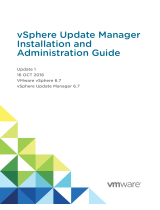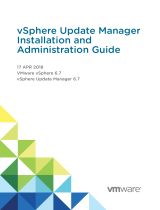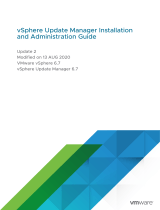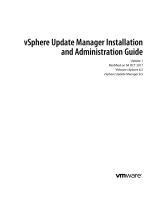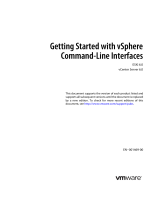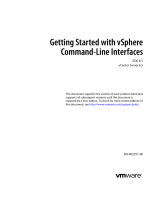Page is loading ...

Dell EMC OpenManage Installation Guide —
Linux
Version 9.5
October 2020
Rev. A01

Notes, cautions, and warnings
NOTE: A NOTE indicates important information that helps you make better use of your product.
CAUTION: A CAUTION indicates either potential damage to hardware or loss of data and tells you how to avoid
the problem.
WARNING: A WARNING indicates a potential for property damage, personal injury, or death.
© 2021 Dell Inc. or its subsidiaries. All rights reserved. Dell, EMC, and other trademarks are trademarks of Dell Inc. or its subsidiaries. Other
trademarks may be trademarks of their respective owners.

Chapter 1: Introduction................................................................................................................. 5
What’s new in this release.................................................................................................................................................5
Software Availability......................................................................................................................................................6
Systems Management Software......................................................................................................................................6
Server Administrator Components On A Managed System................................................................................ 6
Security Features.................................................................................................................................................................8
Other Documents You Might Need................................................................................................................................. 8
Chapter 2: Preinstallation Setup.................................................................................................. 10
Installation Requirements.................................................................................................................................................10
Supported Operating Systems And Web Browsers.............................................................................................10
System Requirements................................................................................................................................................. 10
Managed System Requirements................................................................................................................................11
Supported Systems Management Protocol Standards........................................................................................11
Configuring SNMP Agents............................................................................................................................................... 11
Remote Enablement Requirements............................................................................................................................... 12
Dependent RPMs For Remote Enablement........................................................................................................... 12
Post Installation Configuration For Remote Enablement................................................................................... 13
Winbind configuration for openwsman and sfcb for Red Hat Enterprise Linux operating systems.......... 14
Work around for the libssl issue.............................................................................................................................. 15
Winbind configuration for openwsman and sfcb for SUSE Linux Enterprise Server operating system... 15
Chapter 3: Installing Managed System Software On Supported Linux and VMware ESXi
operating systems.................................................................................................................... 16
Software License Agreement.......................................................................................................................................... 17
RPM for individual components......................................................................................................................................17
OpenIPMI Device Driver.................................................................................................................................................. 20
Degradation Of Functionality When The Server Administrator Instrumentation Service Is Started....... 21
Installing Managed System Software............................................................................................................................21
Prerequisites For Installing Managed System Software..................................................................................... 21
Installing Managed System software using the provided media......................................................................22
Server Administrator Custom Installation Utility................................................................................................. 25
Managed System Software Installation Using Third-Party Deployment Software..................................... 26
Uninstalling Managed System Software...................................................................................................................... 27
Uninstalling Managed System Software Using The Uninstall Script...............................................................27
Uninstalling Managed System Software Using The RPM Command..............................................................28
Chapter 4: Installing Systems Management Software On VMware ESXi.......................................29
Using the vSphere CLI..................................................................................................................................................... 29
Using the VMware vSphere Management Assistant vMA...................................................................................... 30
Using the VMware Update Manager (VUM)...............................................................................................................31
Installing OpenManage Server Administrator using vSphere Lifecycle Manager in vSphere Client..............31
Using The Power CLI........................................................................................................................................................32
Accessing Server Administrator on VMware ESXi.................................................................................................... 33
Contents
Contents 3

Uninstalling the existing Systems Management VIB.................................................................................................33
Configuring The SNMP Agent On Systems Running VMware ESXi.....................................................................33
Configuring The System To Send Traps To A Management Station Using The vSphere CLI..................34
Troubleshooting................................................................................................................................................................. 34
Chapter 5: Upgrading Systems Management Software On VMware ESXi..................................... 35
Using the vSphere CLI..................................................................................................................................................... 35
Using The Power CLI........................................................................................................................................................35
Using the VMware Update Manager (VUM)..............................................................................................................36
Chapter 6: Frequently Asked Questions.......................................................................................38
............................................................................................................................................................................................... 38
Chapter 7: Linux Installer Packages............................................................................................. 43
4 Contents

Introduction
This topic provides information about:
● Installing Server Administrator on managed systems.
● Installing and using the Remote Enablement feature.
● Managing remote systems using Server Administrator Web Server.
● Configuring the system before and during a deployment or upgrade.
NOTE: If you are installing management station and managed system software on the same system, install identical
software versions to avoid system conflicts.
Topics:
• What’s new in this release
• Systems Management Software
• Security Features
• Other Documents You Might Need
What’s new in this release
● Support for Oracle Java Runtime Environment 11.0.7 and Tomcat 9.0.34 bundled with Server Administrator.
● Alternative support for OpenJRE/JDK 11 package in Server Administrator preferences.
Supported new features in Storage Management:
● Support for PERC 11 controllers (PERC H755N, PERC H755 Adapter, PERC H755 Front).
● Support for HBA 11 controllers (HBA 355i Frnt, HBA 355i Adpt).
● Support for Secure boot alerts on PERC 11 controllers.
● Support for NVMe RAID with Dell Express Flash NVMe devices on PERC H755N controller.
● Support for BOSS-S2 device
○ Support for Blink and Unblink for M.2 drives.
○ Support for hot-plug on M.2 drives.
● Support for PCIe Gen-4 drives.
● Supported Operating systems:
○ Red Hat Enterprise Linux 7.8 and Red Hat Enterprise Linux 7.9
○ Red Hat Enterprise Linux 8.2 and Red Hat Enterprise Linux 8.3
○ Suse Linux Enterprise Server 15 SP2
○ VMware ESXi 7.0 and VMware ESXi 7.0 U1
● Supported Network Cards
○ Marvell QLogic Fibre Channel Single Port 32GFC PCIe Gen4 x8 Adapter.
○ Marvell QLogic Fibre Channel Dual Port 32GFC PCIe Gen4 x8 Adapter.
○ Intel(R) Ethernet 25G 2P E810-XXV OCP.
○ Intel(R) Ethernet 25G 2P E810-XXV Adapter.
○ Intel(R) Ethernet 10G 4P X710/I350 rNDC.
○ Intel FPGA Programmable Acceleration Card D5005.
○ Dual Port 10Gb Ethernet (BCM57810S) LOM (FC430).
○ QLogic 57810S-K Dual Port 10Gb bNDC KR CNA.
○ QLogic 57810S-k Dual Port 10Gb bMezz KR CNA.
○ QLogic 57840S-K Quad Port 10Gb bNDC KR CNA.
○ Broadcom BCM57504 25G KR Quad Port Fab AB Mezz.
1
Introduction 5

NOTE:
● For the list of supported operating systems and Dell EMC servers, see the Dell EMC OpenManage Software Support
Matrix in the required version of OpenManage Software at www.dell.com/OpenManageManuals.
● For more information about any features, see the Dell EMC OpenManage Server Administrator Online Help.
Software Availability
The Server Administrator software can be installed from:
● Systems Management Tools and Documentation software
● Support site—For more information, see www.dell.com/Support/Home.
● VMware Update Manager (VUM)—For more information, see http://vmwaredepot.dell.com/.
● Linux Repository using YUM or zypper—For more information, see Linux Repository.
Systems Management Software
Systems management software is a suite of applications that enables you to manage the systems by monitoring, notification,
and remote access.
Systems management software comprises of the ISO Dell EMC Systems Management Tools and Documentation image.
NOTE: For more information about these ISO images, see Dell EMC Systems Management Tools And Documentation
Installation Guide on www.dell.com/OpenManageManuals.
Server Administrator Components On A Managed System
The setup program provides the following options:
● Custom Setup
● Typical Setup
The custom setup option enables you to select the software components you want to install. The table lists the various managed
system software components that you can install during a custom installation.
Table 1. Managed System Software Components
Component What is installed Deployment Scenario Systems to install on
Server Administrator Web
Server
Web-based Systems
Management functionality
that enables you to manage
systems locally or remotely.
Install only if you want to
remotely monitor the
managed system. You do not
require physical access to the
managed system.
Any system. For example,
laptop or desktops.
NOTE: For a list of
supported laptops and
desktops, see the Dell
EMC OpenManage 9.5
Release notes at
dell.com/support/
manuals.
Server Instrumentation Server Administrator
Instrumentation Service
Install to use the system as
the managed system.
Installing Server
Instrumentation and the
Server Administrator Web
Server installs Server
Administrator. Use Server
Administrator to monitor,
configure, and manage the
system.
NOTE: If you choose to
install only Server
Supported systems. For a list
of supported systems, see the
Dell EMC OpenManage
Systems Software Support
Matrix at dell.com/support/
manuals.
6 Introduction

Table 1. Managed System Software Components (continued)
Component What is installed Deployment Scenario Systems to install on
Instrumentation, you must
also install one of the
Management Interfaces or
the Server Administrator
Web Server.
Storage Management Server Administrator Storage
Management
Install to implement hardware
RAID solutions and configure
the storage components that
are attached to the system.
For more information about
Storage Management, see the
Dell EMC OpenManage
Server Administrator Storage
Management User’s Guide in
the docs directory.
Only those systems on which
you have installed Server
Instrumentation or the
Management Interfaces.
Command Line Interface
(Management Interface)
Command Line Interface of
Server Instrumentation
Install to provide local and
remote system management
solutions to manage Server
and Storage instrumentation
data using command-line
interfaces.
Supported systems. For a list
of supported systems, see the
Dell EMC OpenManage
Systems Software Support
Matrix.
WMI (Management Interface) Windows Management
Instrumentation Interface of
Server Instrumentation
Install to provide local and
remote system management
solutions to manage Server
data using WMI protocol.
Supported systems. For a list
of supported systems, see the
Dell EMC OpenManage
Systems Software Support
Matrix.
SNMP (Management
Interface)
Simple Network Management
Protocol Interface of Server
Instrumentation
Install to provide local and
remote system management
solutions to manage Server
and Storage instrumentation
data using SNMP protocol.
Supported systems. For a list
of supported systems, see the
Dell EMC OpenManage
Systems Software Support
Matrix.
Remote Enablement
(Management Interface)
Instrumentation Service and
CIM Provider
Install to perform remote
systems management tasks.
Install Remote Enablement on
one system and Server
Administrator Web Server on
another system. You can use
the system with the Server
Administrator to remotely
monitor and manage the
systems which have Remote
Enablement installed.
Supported systems. For a list
of supported systems, see the
Dell EMC OpenManage
Systems Software Support
Matrix.
Operating System Logging
(Management Interface)
Operating System Logging Install to enable local system
management-specific events
logging on the operating
system for Server and
Storage instrumentation. On
systems running Microsoft
Windows, use the Event
Viewer to locally view the
collected events.
Supported systems. For a list
of supported systems, see the
Dell EMC OpenManage
Systems Software Support
Matrix.
iDRAC Command Line Tools Hardware application
programming interface and
iDRAC (depending on the type
of the system)
Install to receive email alerts
for warnings or errors that are
related to voltage,
temperature, and fan speed.
Remote Access Controller
Only those systems on which
you have installed Server
Instrumentation or
Management Interface.
Introduction 7

Table 1. Managed System Software Components (continued)
Component What is installed Deployment Scenario Systems to install on
also logs event data and the
most recent crash screen
(available only on systems
running Windows operating
system) to help you diagnose
the probable cause of a
system crash.
Security Features
Systems management software components provide the following security features:
● Support for Network Information Services (NIS), Winbind, Kerberos, and Lightweight Directory Access Protocol (LDAP)
authentication protocols for Linux operating systems
● Role-based authority that enables specific privileges to be configured for each user
NOTE: Applicable only for systems running Red Hat Enterprise Linux or VMware ESXi
● User ID and password configuration through the web-based interface or the command-line interface (CLI), in most cases
● SSL encryption (Auto Negotiate and 128-bit or higher)
NOTE: Telnet does not support SSL encryption.
● Session time-out configuration (in minutes) through the web-based interface
● Port configuration to enable systems management software to connect to a remote device through firewalls
NOTE:
For information about ports that the various systems management components use, see the User Guide for that
component.
For information about the Security Management, see the Dell EMC OpenManage Server Administrator User’s Guide at
www.dell.com/openmanagemanuals.
Other Documents You Might Need
For more information, see the following guides:
● The Lifecycle Controller Version 4.00.00.00 User's Guide provides information about using the Lifecycle Controller.
● The Dell EMC OpenManage Management Console User’s Guide provides information about installing, configuring, and using
the Management Console.
● The Systems Build and Update Utility User’s Guide provides information about using the Systems Build and Update Utility.
● The Dell EMC OpenManage Systems Software Support Matrix provides information about the various systems, the
operating systems supported by these systems, and the systems management components that can be installed on these
systems.
● The Dell EMC OpenManage Server Administrator User's Guide describes the installation and use of Server Administrator.
● The Dell EMC OpenManage Server Administrator SNMP Reference Guide documents the SNMP management information
base (MIB).
● The Dell EMC OpenManage Server Administrator CIM Reference Guide documents the Common Information Model (CIM)
provider, which is an extension of the standard management object format (MOF) file. This guide explains the supported
classes of management objects.
● TheDell EMC OpenManage Server Administrator Messages Reference Guide lists the messages that are displayed on the
Server Administrator home page Alert log, or on the event viewer of the operating system. This guide explains the text,
severity, and causes of each alert message that the Server Administrator displays.
● The Dell EMC OpenManage Server Administrator Command Line Interface Guide documents the complete command line
interface for Server Administrator, including an explanation of CLI commands to view system status, access logs, create
reports, configure various component parameters, and set critical thresholds.
● The Remote Access Controller User’s Guide provides complete information about installing and configuring a DRAC
controller and using DRAC to remotely access an inoperable system.
8
Introduction

● The Integrated Remote Access Controller User's Guide provides complete information about configuring and using an
integrated Remote Access Controller to remotely manage and monitor the system and its shared resources through a
network.
● The Update Packages User's Guide provides information about obtaining and using the Update Packages for Windows and
Linux as part of the system update strategy.
● The Server Update Utility User's Guide provides information about using the Server Update Utility.
● The Dell EMC OpenManage Systems Management Tools and Documentation software contains readme files for applications
found on the media.
NOTE: If the product does not perform as expected or you do not understand a procedure described in this guide, see
Getting Help in the system’s Hardware Owner’s Manual.
Introduction 9

Preinstallation Setup
Ensure that you perform the following before installing Server Administrator:
● Read the installation instructions for the operating system.
● Read the Installation Requirements to ensure that the system meets or exceeds the minimum requirements.
● Read the applicable readme files and the Systems Software Support Matrix.
● Close all applications running on the system before installing the Server Administrator applications.
On systems running the Linux operating system, ensure that all operating system RPM Package Manager (RPM) packages
required by the Server Administrator RPMs are installed. If the system had VMware ESXi factory-installed, Red Hat
Enterprise Linux Server, see the Dependent RPMs for Remote Enablement section for information about any RPMs that you
need to manually install before installing managed system software. Typically, manual installation of RPMs is not required.
Topics:
• Installation Requirements
• Configuring SNMP Agents
• Remote Enablement Requirements
• Winbind configuration for openwsman and sfcb for Red Hat Enterprise Linux operating systems
• Work around for the libssl issue
• Winbind configuration for openwsman and sfcb for SUSE Linux Enterprise Server operating system
Installation Requirements
This section describes the general requirements of the Server Administrator and provides information about supported operating
systems and web browsers.
NOTE:
● Prerequisites specific to an operating system are listed as part of the installation procedures.
● Server Administrator 9.5 RPM packages have been signed with Dell SHA-512 signature key. The installation or upgrade
from previous versions of Server administrator to Server Administrator 9.5 prompts you an interactive message. During
silent installation or upgrade, you must download the key from the following location:
https://linux.dell.com/repo/hardware/dsu/public_gpg3.key
Before installing or upgrading Server Administrator 9.5, you must import the Dell SHA-512 key once to each host with
rpm --import <key file>. Once the key is imported, you are not required to import the key every time while
installing, or upgrading to 9.5.
Supported Operating Systems And Web Browsers
For information about the supported operating systems and web browsers, see the Dell EMC OpenManage Systems Software
Support Matrix available at www.dell.com/openmanagemanuals.
NOTE: Ensure that the web browser is configured to bypass the proxy server for local addresses.
System Requirements
Install Server Administrator on each system that requires to be managed. You can manage each system running Server
Administrator locally or remotely through a supported web browser.
2
10 Preinstallation Setup

NOTE: For the list of supported operating systems and Dell EMC servers, see the Dell EMC OpenManage Software
Support Matrix in the required version of OpenManage Software at www.dell.com/openmanagemanuals.
Managed System Requirements
● One of the supported operating systems and web browser
● Minimum 2 GB RAM
● Minimum 512 MB free hard drive space
● Administrator rights
● TCP/IP connection on the managed system and the remote system to facilitate remote system management.
● One of the Supported Systems Management Protocol Standards
● Monitor with a minimum screen resolution of 800 x 600. The recommended screen resolution is at least 1024 x 768.
● The Server Administrator Remote Access Controller service requires remote access controller (RAC) installed on the
managed system. See the relevant Remote Access Controller User’s Guide for complete software and hardware
requirements.
● The Server Administrator Storage Management Service requires Server Administrator that is installed on the managed
system. See the Dell EMC OpenManage Server Administrator Storage Management User’s Guide for complete software and
hardware requirements.
Related Link:
Supported Operating Systems and Web Browsers
Supported Systems Management Protocol Standards
Install a supported systems management protocol on the managed system before installing the management station or managed
system software. On supported Linux operating system, systems management software supports:
● Common Information Model (CIM)
● Simple Network Management Protocol (SNMP)
Install the SNMP package provided with the operating system. If SNMP is installed post Server Administrator installation, restart
Server Administrator services.
NOTE:
For information about installing a supported systems management protocol standard on the managed system, see
the operating system documentation.
The following table shows the availability of the systems management standards for each supported operating system:
Table 2. Availability of Systems Management Protocol by Operating Systems
Operating System SNMP/CIM
Supported Red Hat Enterprise Linux operating system. Install the SNMP/CIM package provided with the operating
system.
Supported SUSE Linux Enterprise Server operating system. Install the SNMP/CIM package provided with the operating
system.
NOTE: Dell EMC recommends installing the SFCB, SFCC, OpenWSMan, and CMPI packages from the operating system
media, if available.
Configuring SNMP Agents
The systems management software supports the SNMP systems management standard on all supported operating systems. The
SNMP support may or may not be installed depending on the operating system and how the operating system was installed. An
installed supported systems management protocol standard, such as SNMP, is required before installing the systems
management software.
Configure the SNMP agent to change the community name, enable set operations, and send traps to a management station. To
configure the SNMP agent for proper interaction with management applications, perform the procedures that are described in
the Dell EMC OpenManage Server Administrator User’s Guide.
Preinstallation Setup
11

Related Links:
● Installation Requirements
● Supported Systems Management Protocol Standards
Remote Enablement Requirements
The Remote Enablement feature is supported on:
● Red Hat Enterprise Linux
● SUSE Enterprise Linux
● VMware vSphere (ESXi)
Dependent RPMs For Remote Enablement
If you choose to install the Remote Enablement feature, you have to install certain dependent RPMs and configure these RPMs
before installing the feature. Install the following RPMs:
● libcmpiCppImpl0
● libwsman1 (RHEL)
● libwsman3 (SLES15)
● openwsman-server
● sblim-sfcb
● sblim-sfcc
NOTE: Make sure that Pegasus RPMs are uninstalled.
Installing Dependent RPMs
To install the dependent RPMs not available on the operating system media:
1. Make sure that Pegasus RPMs are uninstalled.
2. Check if the openwsmand and sfcbd binaries are already installed using make-install. Check by running the commands:
openwsman or sfcbd or you can check the existence of the binaries in the /usr/local/sbin directory.
3. If the binaries are installed, uninstall these binaries.
4. Check for the required dependencies for the openwsman and sfcbd RPMs listed in the following table.
Table 3. Required Dependencies
Packages Red Hat Enterprise Server SUSE Linux Enterprise Server
Openwsman OpenSSL
LibXML
Pkgconfig
CURL
Chkconfig
Initscript
SBLIM-SFCC
LibOpenSSL
LibXML
Pkg-config
libCURL
aaa_base
aaa_base
SBLIM-SFCC
SBLIM SFCC CURL LibCURL
SBLIM SFCB zlib
CURL
PAM
OpenSSL
Chkconfig
Initscript
zlib
LibCURL
PAM
LibOpenSSL
aaa_base
aaa_base
5. Install the dependent RPMs. You can install the RPMs:
12
Preinstallation Setup

● with a single command rpm -ivh rpm1 rpm2 rpm3 rpm4 … rpmN
or
● individually
NOTE: If you are installing RPMs individually, follow this sequence.
rpm -ivh sblim-sfcb-x.x.x.rpm
rpm -ivh sblim-sfcc-x.x.x.rpm
NOTE: Install the libwsman and openwsman client RPMs simultaneously as they have cyclic dependency.
rpm -ivh libwsman1-x.x.x.rpm openwsman-client-x.x.x.rpm
rpm -ivh openwsman-server-x.x.x.rpm
Post Installation Configuration For Remote Enablement
This section details the steps to configure the dependent RPMs if you have installed the Remote Enablement feature.
The post installation configuration script is available at /opt/dell/srvadmin/etc/ on the server file system.
After installing all the dependent RPMs and the Remote Enablement feature, run the autoconf_cim_component.sh script.
Before running the autoconf_cim_component.sh script, ensure that Systems Management is installed.
Run the following command to configure sfcb and openwsman as per the default configurations: ./
autoconf_cim_component.sh
NOTE:
To configure openwsman on the managed node to run on a different port, use the -p <
port
> option with
autoconf_cim_component.sh. This is optional and by default the openwsman is configured to run on port 443.
NOTE: To successfully use openwsmand and sfcbd services on systems running the supported Linux server operating
system with SELinux enabled, use the following commands:
● openwsmand
#grep openwsmand /var/log/audit/audit.log | audit2allow -M mypol
#semodule -i mypol.pp
● sfcbd
#grep sfcbd /var/log/audit/audit.log | audit2allow -M mypol
#semodule -i mypol.pp
Related Links:
Installing Managed System Software on Supported Linux and VMware ESX
Creating Server Certificate For WSMan
You can either create a certificate for WSMan or reuse an existing certificate.
Creating A New Certificate
You can create a new server certificate for WSMan by running the owsmangencert.sh script that is /etc/openwsman. The
openwsman RPM provides the script. Follow the steps in the wizard to create the server certificate.
NOTE:
On RHEL8, comment RANDFILE and change bits to 2048 in ssleay.cnf before running owsmangencert.sh for
openwsman to run properly .
Preinstallation Setup 13

Reusing An Existing Certificate
If you have a self-signed or CA-signed certificate, you can use the same certificate for the openwsman server by updating the
ssl_cert_file and ssl_key_file values, which are grouped under [server] tag, in /etc/openwsman/
openwsman.conf with the existing certificate values.
Configuring CRL for the openwsman client
To configure the Certificate Revocation List (CRL) used by Server Administrator Web Server, do the following:
1. Mention a valid CRL file in /etc/openwsman/openwsman_client.conf.
2. If left blank, the CRL check is ignored.
NOTE: CRL support is only present on the supported SUSE Linux Enterprise Server and Red Hat Enterprise Linux
Server. For other operating systems, contact the operating system vendor to provide the required CURL library with
CRL support.
Running sfcb and openwsman
Run sfcb and openwsman:
● /etc/init.d/sfcb start
● /etc/init.d/openwsmand start
NOTE: On Red Hat Enterprise Linux 6, replace sfcb with sblim-sfcb.
On Red Hat Enterprise Linux 6, for the sblim-sfcb and openwsman to start automatically after a reboot you need to change
the run-levels using the chkconfig utility. For example, if you want to run sblim-sfcb in run-levels 3 and 5, use the
following command:
#chkconfig sblim-sfcb on --level 35
NOTE: For more information about chkconfig and its usage, see the operating system documentation.
The managed system is configured and is ready to be used by the Server Administrator Web Server.
Winbind configuration for openwsman and sfcb for
Red Hat Enterprise Linux operating systems
Perform the following to configure openwsman and sfcb:
1. Back up these files:
● /etc/pam.d/openwsman
● /etc/pam.d/sfcb
● /etc/pam.d/system-auth
2. Replace the content of /etc/pam.d/openwsman and /etc/pam.d/sfcb with the following:
auth required pam_stack.so service=system-auth
auth required /lib/security/pam_nologin.so
account required pam_stack.so service=system-auth
3. Replace the content of /etc/pam.d/system-auth with the following:
%PAM-1.0
This file is auto-generated.
User changes will be destroyed the next time authconfig is run.
auth required /lib/security/$ISA/pam_env.so
14
Preinstallation Setup

auth sufficient /lib/security/$ISA/pam_unix.so likeauth nullok
auth sufficient /lib/security/$ISA/pam_krb5.so use_first_pass
auth sufficient /lib/security/$ISA/pam_winbind.so use_first_pass
auth required /lib/security/$ISA/pam_deny.so
account required /lib/security/$ISA/pam_unix.so broken_shadow
account sufficient /lib/security/$ISA/pam_succeed_if.so uid 100 quiet
account [default=bad success=ok user_unknown= ignore] /lib/security/$ISA/pam_krb5.so
account [default=bad success=ok user_unknown= ignore] /lib/security/$ISA/
pam_winbind.so
account required /lib/security/$ISA/pam_permit.so
password requisite /lib/security/$ISA/pam_cracklib.so retry=3
password sufficient /lib/security/$ISA/pam_unix.so nullok use_authtok md5 shadow
password sufficient /lib/security/$ISA/pam_krb5.so use_authtok
password sufficient /lib/security/$ISA/pam_winbind.so use_authtok
password required /lib/security/$ISA/pam_deny.so
session required /lib/security/$ISA/pam_limits.so
session required /lib/security/$ISA/pam_unix.so
session optional /lib/security/$ISA/pam_krb5.so
Work around for the libssl issue
If the required library needed by openwsman is present on the system, the autoconf_cim_component.sh script tries to
resolve the libssl.so issue. However, if the library is not present, the script reports the same. Check if the latest version of the
libssl library is installed on the system and then create a soft link with libssl.so.
For example: if you have libssl.so.0.9.8a and libssl.so.0.9.8b in /usr/lib, create soft link with the latest
libssl.so.0.9.8b:
● ln -sf /usr/lib64/libssl.so.0.9.8b /usr/lib64/libssl.so
● ldconfig
Winbind configuration for openwsman and sfcb for
SUSE Linux Enterprise Server operating system
Perform the following to configure openwsman and sfcb:
1. Back up the following files:
● /etc/pam.d/openwsman
● /etc/pam.d/sfcb
● /etc/pam.d/system-auth
● /etc/pam.d/common-account
2. Replace the content of /etc/pam.d/openwsman/ and /etc/pam.d/sfcb with the following:
%PAM-1.0
auth include common-auth
auth required /lib/security/pam_nologin.so
account include common-account
3. Replace the content of /etc/pam.d/common-auth with the following:
auth required pam_env.so
auth sufficient pam_unix2.so debug
auth sufficient pam_winbind.so use_first_pass debug
4. Replace the content of /etc/pam.d/common-account with the following:
account sufficient pam_unix2.so
account sufficient pam_winbind.so
Preinstallation Setup
15

Installing Managed System Software On
Supported Linux and VMware ESXi operating
systems
The following table explains the operating system installation matrix for Systems Management.
Table 4. Operating System Installation Matrix
Operating System Architecture 64-bit Architecture
Red Hat Enterprise Linux 8.2 and Red Hat Enterprise Linux 8.3 Install
Red Hat Enterprise Linux 7.8 and Red Hat Enterprise Linux 7.9 Install
SUSE Linux Enterprise Server 15 SP2 Install
VMware ESXi 7.0 and VMware ESXi 7.0 U1
Install
NOTE:
● On a Systems Management upgrade, Dell EMC recommends upgrading to the latest open-source components available
on the Dell EMC OpenManage Systems Management Tools and Documentation software or from www.dell.com/
Support/Home.
● If you are upgrading the operating system to a major version, uninstall the existing version of Systems Management and
install the supported version.
The installation scripts and RPM packages specific to supported Linux and VMware ESXi operating systems are provided to
install and uninstall the Server Administrator and other managed system software components. These installation scripts and
RPMs are located in the SYSMGMT/srvadmin/linux/supportscripts directory available in the Dell EMC OpenManage
Systems Management Tools and Documentation software.
NOTE:
Before you migrate to Systems Management software, ensure that you uninstall the Systems Management and
other open-source components (openwsman-server, openwsman-client, libwsman1, sblim-sfcb, sblim-sfcc,
libcmpiCppImpl0, libsmbios2, smbios-utils-bin) installed as part of the Systems Management.
The install script srvadmin-install.sh enables silent or interactive installation. By including the srvadmin-install.sh script in
the Linux scripts, install Server Administrator locally or across a network on single or multiple systems.
The second install method uses the Server Administrator RPM packages that are provided in the custom directories and the
Linux rpm command. Write Linux scripts that install Server Administrator locally or across a network on single or multiple
systems.
Using a combination of the two install methods is not recommended and may require that you manually install the required
Server Administrator RPM packages provided in the custom directories, using the Linux rpm command.
For information about supported platforms and supported operating systems, see the Dell EMC OpenManage Systems Software
Support Matrix at www.dell.com/OpenManageManuals.
Topics:
• Software License Agreement
• RPM for individual components
• OpenIPMI Device Driver
• Installing Managed System Software
• Uninstalling Managed System Software
3
16 Installing Managed System Software On Supported Linux and VMware ESXi operating systems

Software License Agreement
The software license for the Red Hat Enterprise Linux Server and SUSE Linux Enterprise Server version of the Systems
Management software is located on the Dell EMC OpenManage Systems Management Tools and Documentation software.
Read the license.txt file. By installing or copying any of the files on the provided media, you are agreeing to the terms in
this file. This file is also copied to the root of the software tree where you install the Systems Management software.
RPM for individual components
The following table lists the RPMs for individual components that can be used during installation:
Table 5. RPM for Individual Components
Prerequisite RPM Deamons Names Command-Line
Options for
srvadmin-install.sh
Server Administrator
Web Server
OS
srvadmin-omilcore
srvadmin-omcommon
srvadmin-jre
srvadmin-omacs
srvadmin-tomcat
srvadmin-smcommon
srvadmin-smweb
dsm_om_connsvcd -w or --web
Server Instrumentation PE Server, OS
(For systems running
Red Hat Enterprise
Linux, install net-snmp-
utils. For systems
running SUSE Linux
Enterprise, install net-
snmp)
srvadmin-omilcore
srvadmin-smcommon
srvadmin-omacore
srvadmin-deng
srvadmin-hapi
srvadmin-isvc
srvadmin-omcommon
srvadmin-isvc-snmp
srvadmin-deng-snmp
srvadmin-cm
srvadmin-omacs
srvadmin-ominst
srvadmin-xmlsup
dsm_sa_datamgrd
dsm_sa_eventmgrd
dsm_sa_snmpd
dsm_om_shrsvcd
-d or --dellagent
Server Instrumentation
Only
PE Server, OS
srvadmin-xmlsup
srvadmin-hapi
srvadmin-omilcore
srvadmin-deng
srvadmin-isvc
srvadmin-omcommon
srvadmin-cm
srvadmin-omacs
srvadmin-ominst
dsm_sa_datamgrd
dsm_sa_eventmgrd
dsm_om_shrsvcd
-g or --agent
Installing Managed System Software On Supported Linux and VMware ESXi operating systems 17

Table 5. RPM for Individual Components (continued)
Prerequisite RPM Deamons Names Command-Line
Options for
srvadmin-install.sh
SNMP PE Server, OS
(For systems running
Red Hat Enterprise
Linux, install net-snmp-
utils. For systems
running SUSE Linux
Enterprise, install net-
snmp).
srvadmin-xmlsup
srvadmin-hapi
srvadmin-omilcore
srvadmin-deng
srvadmin-isvc
srvadmin-omcommon
srvadmin-isvc-snmp
srvadmin-deng-snmp
srvadmin-cm
srvadmin-omacs
srvadmin-ominst
dsm_sa_datamgrd
dsm_sa_eventmgrd
dsm_sa_snmpd
dsm_om_shrsvcd
-m or --snmp
CLI PE Server, OS
srvadmin-xmlsup
srvadmin-hapi
srvadmin-omilcore
srvadmin-deng
srvadmin-isvc
srvadmin-omcommon
srvadmin-omacore
srvadmin-cm
srvadmin-omacs
srvadmin-ominst
dsm_sa_datamgrd
dsm_sa_eventmgrd
dsm_sa_shrsvcd
-i or --cli
OS Logging Option PE Server, OS
srvadmin-xmlsup
srvadmin-hapi
srvadmin-omilcore
srvadmin-deng
srvadmin-isvc
srvadmin-omcommon
srvadmin-oslog
srvadmin-cm
srvadmin-omacs
srvadmin-ominst
dsm_sa_datamgrd
dsm_sa_eventmgrd
dsm_sa_shrsvcd
-l or --oslog
Remote Enablement PE Server, OS,
CIMOM,WSMan
CIMOM version >=
SFCB 1.3.2 (applicable
for systems running
Red Hat Enterprise
Linux, and SUSE Linux)
WSMan Version >=
OpenWSMAN 2.1
srvadmin-xmlsup
srvadmin-hapi
srvadmin-omilcore
srvadmin-deng
srvadmin-omacs
srvadmin-ominst
srvadmin-isvc-snmp
dsm_sa_datamgrd
dsm_sa_eventmgrd
dsm_sa_snmpd
dsm_sa_shrsvcd
-c or --cimagent
18 Installing Managed System Software On Supported Linux and VMware ESXi operating systems

Table 5. RPM for Individual Components (continued)
Prerequisite RPM Deamons Names Command-Line
Options for
srvadmin-install.sh
(For systems running
Red Hat Enterprise
Linux, install net-snmp-
utils. For systems
running SUSE Linux
Enterprise, install net-
snmp)
srvadmin-deng-snmp
srvadmin-isvc
srvadmin-omcommon
srvadmin-omacore
srvadmin-cm
srvadmin-smcommon
srvadmin-
itunnelprovider
Storage Agent and
Server Instrumentation
(For systems running
Red Hat Enterprise
Linux, install net-snmp-
utils. For systems
running SUSE Linux
Enterprise, install net-
snmp).
srvadmin-xmlsup
srvadmin-sysfsutils
srvadmin-storelib-sysfs
srvadmin-storelib
srvadmin-hapi
srvadmin-omilcore
srvadmin-deng
srvadmin-deng-snmp
srvadmin-isvc
srvadmin-isvc-snmp
srvadmin-omcommon
srvadmin-omacore
srvadmin-omacs
srvadmin-ominst
srvadmin-cm
srvadmin-realssd
(applicable for x86_64
bit only)
srvadmin-smcommon
srvadmin-storage
srvadmin-storage-cli
srvadmin-storage-snmp
dsm_sa_datamgrd
dsm_sa_eventmgrd
dsm_sa_snmpd
dsm_om_shrsvcd
-s or --storage
Remote Access SA
Plugin Component ->
Remote access core
components, Server
Instrumentation
iDRAC agent is installed
if iDRAC card is
available in the server.
iDRAC agent is installed
for yx1x generation and
yx2x generation of
PowerEdge servers
with RAC presence.
(For systems running
Red Hat Enterprise
Linux, install net-snmp-
utils. For systems
running SUSE Linux
srvadmin-xmlsup
srvadmin-hapi
srvadmin-argtable2
srvadmin-omilcore
srvadmin-deng
srvadmin-deng-snmp
srvadmin-isvc
srvadmin-isvc-snmp
srvadmin-omcommon
srvadmin-omacs
dsm_sa_datamgrd
dsm_sa_eventmgrd
dsm_sa_snmpd
dsm_om_shrsvcd
-r or --rac
Installing Managed System Software On Supported Linux and VMware ESXi operating systems 19

Table 5. RPM for Individual Components (continued)
Prerequisite RPM Deamons Names Command-Line
Options for
srvadmin-install.sh
Enterprise, install net-
snmp)
srvadmin-ominst
srvadmin-omacore
srvadmin-cm
srvadmin-smcommon
srvadmin-idracadm7
srvadmin-idrac-vmcli
Storage Agent and
Server Instrumentation
PE Server, OS
srvadmin-xmlsup
srvadmin-hapi
srvadmin-omacs
srvadmin-ominst
srvadmin-omilcore
srvadmin-deng
srvadmin-isvc
srvadmin-cm
dsm_sa_datamgrd
dsm_sa_eventmgrd
dsm_om_shrsvcd
-t or --stragent
Remote Enablement
and Server
Instrumentation
PE Server, OS
srvadmin-xmlsup
srvadmin-hapi
srvadmin-omilcore
srvadmin-deng
srvadmin-isvc
srvadmin-cm
srvadmin-omacs
srvadmin-ominst
srvadmin-
itunnelprovider
dsm_sa_datamgrd
dsm_sa_eventmgrd
dsm_om_shrsvcd
-z or --corecim
NOTE: To manage the server, select either Server Administrator Web Server or one of the Management Interfaces – CLI,
SNMP, or OS LOG along with Server Instrumentation (SI) or Server Administrator Storage Management Service (OMSS).
NOTE: Command-line options for [-t] and [-g] cannot be used without a management interface. These options must be
combined with management interface options such as [-w], [-i], [-z], [-l], or [-m]. For more information about custom
installations, see Server Administrator Custom Installation Utility.
OpenIPMI Device Driver
The Server Instrumentation feature of Server Administrator requires the OpenIPMI device driver that provides IPMI-based
information and functionality.
All supported Linux systems contain the required version of IPMI module in the default kernel itself. You do not have to install
the IPMI RPM. For more information on supported systems, see the Dell EMC OpenManage Systems Software Support Matrix.
20
Installing Managed System Software On Supported Linux and VMware ESXi operating systems
/
